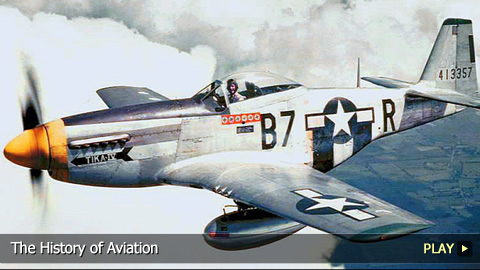The History of Aviation

Since our earliest days, humankind has dreamed of soaring through the sky alongside the birds. Welcome to WatchMojo.com, and today we’ll be taking a look at the history of aviation.
Man has been building primitive flying apparatuses since before the Common Era. However, famed Italian inventor Leonardo da Vinci is credited with designing early ancestors of the airplane based on the flight of birds, including the parachute and an early version of the propeller.
1783 was considered a breakthrough year in aviation: for example, hot air balloons became popular in Europe with help from the Montgolfier brothers.
More significant advances came at the end of the nineteenth century when gliders became more well-developed. In 1848, John Stringfellow managed the first powered flight by using a steam-powered flying machine.
Lawrence Hargrave then helped develop the rotary engine by introducing the use of compressed air. Also involved in the flight race was Samuel Pierpont Langley, who attempted several unpiloted and piloted efforts. His Aerodrome was later considered the first machine capable of flight.
Just days after Langley gave up his attempts, the Wright brothers achieved a breakthrough. On December 17th, 1903, Orville and Wilbur Wright managed the first reputable instance of sustained flight by a heavier-than-air vehicle they called the Wright Flyer.
This first flight traveled 120 feet in 12 seconds. Within five years, the Wrights had lengthened their flight time to over an hour; unfortunately, shortly thereafter their projects prompted the first instance of an airplane passenger death due to a crash.
Despite this setback, flight quickly became ubiquitous, and its use increased exponentially because of its role as a military tool.
Leading up to World War I, airplanes were mainly used for photography and reconnaissance missions, and not as weapons of war. To make them viable tools, they required major revisions: these ranged from the creation of pusher biplanes – where the engine and propeller were located behind the wing – to tractor biplanes, which featured these devices in front of the wing.
Finally, when it was ensured that machine guns could be steadily mounted, air warfare became a reality with the invention of fighter planes. Soon after the onset of war, planes became devastating aerial bombers when they began to feature two to four engines.
In the period between the World Wars, many of important innovations took place. Instead of wood, planes were built of aluminum, and they became much more powerful, as well. Airmail also became a reality, as did transcontinental flight. Flight records were constantly broken, and the first round-the-world trip occurred in 1924.
World War II firmly established fixed wing aircraft as a decisive factor for military victory. By the time the smoke cleared over Europe, humanity had developed jet and rocket propulsion, as well as radar technology. The importance of aircraft to warfare only increased with the advent of the nuclear bomb.
In 1945, a minor military contractor named Boeing became the largest aircraft manufacturer in the world. They developed new technologies that allowed for pressurized cabins, more aerodynamic designs, new metals, larger sizes and turbo-jets capable of supersonic speed.
By 1947, the sound barrier was broken, and regular transoceanic flights became a reality within two years. Boeing introduced the B-52 in the 1950s, and this strategic bomber was equipped with eight turbo-jet engines, intercontinental range and a capacity of half a million pounds.
In 1963, a small jet aircraft called the Learjet became a reality. Six years later, Boeing developed the revolutionary 747. That wide-bodied turbo-fan powered commercial airliner became the most successful model ever created, and it served as the foundation for countless other models.
The 1970s saw the arrival of the supersonic Concorde jet and the Airbus. Leading up to the ‘90s, designers began adapting a flying wing design and the use of composite metals. While this effectively made conventional radar obsolete, it was meant only for military applications. This also spurred the creation of crafts like Lockheed Martin’s F-117 stealth fighter.
Air travel has become the fastest method of global transportation, and a major pillar of warfare. Disasters like the Hindenburg acted as cautionary tales, but flight has advanced to the point where it is now labeled as the safest means available.
